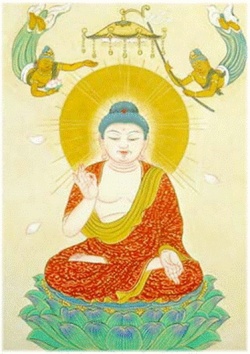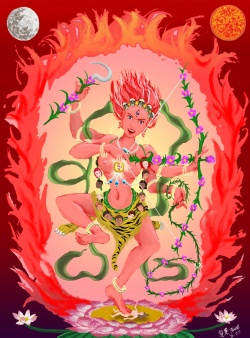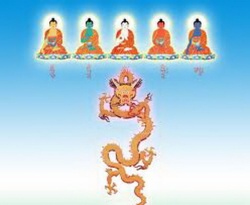Difference between revisions of "Twilight Language"
(Created page with " Twilight language is a rendering of the Sanskrit term sāṃdhyābhāṣā (written also sāndhyābhāṣā, sāṃdhyabhāṣā, sāndhyabhāṣā; ...") |
|||
| (3 intermediate revisions by the same user not shown) | |||
| Line 1: | Line 1: | ||
| − | + | {{DisplayImages|3189|1857|1213|728}} | |
| + | <poem> | ||
| + | [[Twilight language]] is a rendering of the [[Sanskrit]] term [[sāṃdhyābhāṣā]] (written also [[sāndhyābhāṣā]], [[sāṃdhyabhāṣā]], [[sāndhyabhāṣā]]; Standard [[Tibetan]]: [[dgongs-pa'i skad]]) — or of their {{Wiki|modern}} [[Indic]] equivalents (especially in {{Wiki|Bengali}}, [[Oriya]], Assamese, Maithili, {{Wiki|Hindi}}, {{Wiki|Nepali}}, Braj and Khariboli). | ||
As popularized by Roderick Bucknell and Martin Stuart-Fox in 1986, the notion of "[[twilight language]]" is a supposed {{Wiki|polysemic}} [[language]] and {{Wiki|communication}} system associated with [[tantric]] [[traditions]] in [[Vajrayana]] [[Buddhism]] and [[Hinduism]]. It includes [[visual]] {{Wiki|communication}}, [[verbal]] {{Wiki|communication}} and nonverbal {{Wiki|communication}}. [[Tantric]] texts are often written in a [[form]] of the [[twilight language]] that is incomprehensible to the uninitiated reader. As part of an [[esoteric]] [[tradition]] of [[initiation]], the texts are not to be employed by those without an [[experienced]] guide and the use of the [[twilight language]] ensures that the uninitiated do not easily gain access to the [[knowledge]] contained in these works. | As popularized by Roderick Bucknell and Martin Stuart-Fox in 1986, the notion of "[[twilight language]]" is a supposed {{Wiki|polysemic}} [[language]] and {{Wiki|communication}} system associated with [[tantric]] [[traditions]] in [[Vajrayana]] [[Buddhism]] and [[Hinduism]]. It includes [[visual]] {{Wiki|communication}}, [[verbal]] {{Wiki|communication}} and nonverbal {{Wiki|communication}}. [[Tantric]] texts are often written in a [[form]] of the [[twilight language]] that is incomprehensible to the uninitiated reader. As part of an [[esoteric]] [[tradition]] of [[initiation]], the texts are not to be employed by those without an [[experienced]] guide and the use of the [[twilight language]] ensures that the uninitiated do not easily gain access to the [[knowledge]] contained in these works. | ||
| Line 31: | Line 33: | ||
Nayak (2006: p. 72) holds the great {{Wiki|fertile}} locality of Sonepur and its {{Wiki|literature}} is championed by such as the [[Charyapada]], Matsyendranath, Daripada and the [[Nath]]: | Nayak (2006: p. 72) holds the great {{Wiki|fertile}} locality of Sonepur and its {{Wiki|literature}} is championed by such as the [[Charyapada]], Matsyendranath, Daripada and the [[Nath]]: | ||
| − | "The growth of {{Wiki|literature}} at Sonepur can be traced to [[Charyapada]], to Matsyendranath and Daripada of the [[Natha]] {{Wiki|cult}}. They wrote [[esoteric]] [[poetry]] in [[language]] known as | + | "The growth of {{Wiki|literature}} at Sonepur can be traced to [[Charyapada]], to Matsyendranath and Daripada of the [[Natha]] {{Wiki|cult}}. They wrote [[esoteric]] [[poetry]] in [[language]] known as [[Sandhya bhasa]]. The local idioms they used are still in currency in this area." |
Refutation of the translation of "[[twilight language]]" | Refutation of the translation of "[[twilight language]]" | ||
| − | In 1969, {{Wiki|Mircea Eliade}} presented {{Wiki|evidence}} that the {{Wiki|concept}} of "{{Wiki|twilight}}" (or "crepuscular") [[language]] is based on a translation error. According to [[Wikipedia:Mircea Eliade|Eliade]], in 1916 Haraprasād Shāstri proposed the translation of "[[twilight language]]". However in 1928 Vidhushekar Shāstri debunked that translation, showing that the term is based on a shortened [[form]] of the [[word]] [[sandhāya]], which can be translated as "[[having in view]]", "[[intending]]", "[[with regard to]]", etc. [[Wikipedia:Mircea Eliade|Eliade]] concludes that: "Hence there is no reference to the [[idea]] of a '[[twilight language]]'." He continues by speculating on how the term came to be corrupted by scribes who read the familiar [[word]] [[sandhyā]] ("crepuscular") for the original sandhā. [[Wikipedia:Mircea Eliade|Eliade]] therefore translates the [[phrase]] as " | + | In 1969, {{Wiki|Mircea Eliade}} presented {{Wiki|evidence}} that the {{Wiki|concept}} of "{{Wiki|twilight}}" (or "crepuscular") [[language]] is based on a translation error. According to [[Wikipedia:Mircea Eliade|Eliade]], in 1916 Haraprasād Shāstri proposed the translation of "[[twilight language]]". However in 1928 Vidhushekar Shāstri debunked that translation, showing that the term is based on a shortened [[form]] of the [[word]] [[sandhāya]], which can be translated as "[[having in view]]", "[[intending]]", "[[with regard to]]", etc. [[Wikipedia:Mircea Eliade|Eliade]] concludes that: "Hence there is no reference to the [[idea]] of a '[[twilight language]]'." He continues by speculating on how the term came to be corrupted by scribes who read the familiar [[word]] [[sandhyā]] ("[[crepuscular]]") for the original [[sandhā]]. [[Wikipedia:Mircea Eliade|Eliade]] therefore translates the [[phrase]] as "[[Intentional Language]]". |
| + | </poem> | ||
| + | {{W}} | ||
| + | [[Category:Twilight Language]] | ||
Latest revision as of 10:19, 16 March 2014
Twilight language is a rendering of the Sanskrit term sāṃdhyābhāṣā (written also sāndhyābhāṣā, sāṃdhyabhāṣā, sāndhyabhāṣā; Standard Tibetan: dgongs-pa'i skad) — or of their modern Indic equivalents (especially in Bengali, Oriya, Assamese, Maithili, Hindi, Nepali, Braj and Khariboli).
As popularized by Roderick Bucknell and Martin Stuart-Fox in 1986, the notion of "twilight language" is a supposed polysemic language and communication system associated with tantric traditions in Vajrayana Buddhism and Hinduism. It includes visual communication, verbal communication and nonverbal communication. Tantric texts are often written in a form of the twilight language that is incomprehensible to the uninitiated reader. As part of an esoteric tradition of initiation, the texts are not to be employed by those without an experienced guide and the use of the twilight language ensures that the uninitiated do not easily gain access to the knowledge contained in these works.
The phrase "twilight language" has subsequently been adopted by some other Western writers. For example, according to Judith Simmer-Brown (2002):
As has often been said, tantric texts are written in "twilight language" (sandha-bhasa, gongpay-kay), which, as the Hevajra-tantra states, is a "secret language, that great convention of the yoginis, which the shravakas and others cannot unriddle". This means that the texts of Buddhist tantra cannot be understood without the specific oral commentary by authorized Vajrayana teachers.
A book by two westerners
The Twilight Language: Explorations in Buddhist Meditation and Symbolism, a 1986 book by Roderick Bucknell and Martin Stuart-Fox, asserts that there is a "twilight language" employed in some sacred texts and communication systems within dharmic traditions. The authors argue that this twilight language is used to convey sub rosa meanings and conceal esoteric truths through intentionally opaque language, metaphor, gesture, codes and signs.
To provide a cypher of the code of saṃdhyā-bhāṣā, the authors drew upon: semiotics, symbolism, iconography, Asian religions, Asian Philosophy, Indian religions, Indian philosophy, Buddhist symbolism, temple architecture, cosmology, mathematical notations, Zen Buddhism, Japanese Art, meditation, personal sadhana, tantra, macrocosm-microcosm parallelism, dialogue with many teachers including Anagarika Govinda and senior members of the Krishnamurti community. (1986: p.vii-xiii)
Classifications and numerology
Numbers, numerology and the spirituality of numerals is key to the twilight language and endemic to Vajrayana, as it is throughout Indian religions. Numbers that are particularly frequent in classification are three, five and nine. As Bucknell and Stuart-Fox (1986: p. 110) state:
The fivefold classification presented in the tantras is remarkably comprehensive, embracing objects of every conceivable type; it includes the infamous set of 'five Ms' (fish, meat, wine, mudrā, sexual intercourse) and even a set of five 'body fluids' faeces, urine, blood, semen, flesh. In addition it includes sets of doctrinal principles, such as the five skandhas (factors of existence), the four kāyas (Buddha-bodies) and the triad prajña, upāya, bodhicitta (wisdom, means, enlightenment-mind). For example, prajña, upāya, and bodhicitta are identified with the triads female/male/union, Amitābha/Akṣobhya/Vairocana, and so on, and are thus implicitly assigned to the water, fire, and space groups respectively.
Pali Canon
Although twilight language is primarily a feature of esoteric traditions such as the Vajrayana, Bucknell and Stuart-Fox (1986: p.vii) cite the Thai bhikkhu Buddhadasa as having explored "the importance of symbolic language in the Pali canon...in a number of lectures and publications."
Vajrayana Tradition
As Bucknell and Stuart-Fox (1986: p.vii) state:
In the Vajrayana tradition, now preserved mainly in Tibetan sects, it has long been recognized that certain important teachings are expressed in a form of secret symbolic language known as saṃdhyā-bhāṣā, 'Twilight Language'. Mudrās and mantras, maṇḍalas and cakras, those mysterious devices and diagrams that were so much in vogue in the Buddhist culture of the 1960s, were all examples of Twilight Language
Sonepur literature
Nayak (2006: p. 72) holds the great fertile locality of Sonepur and its literature is championed by such as the Charyapada, Matsyendranath, Daripada and the Nath:
"The growth of literature at Sonepur can be traced to Charyapada, to Matsyendranath and Daripada of the Natha cult. They wrote esoteric poetry in language known as Sandhya bhasa. The local idioms they used are still in currency in this area."
Refutation of the translation of "twilight language"
In 1969, Mircea Eliade presented evidence that the concept of "twilight" (or "crepuscular") language is based on a translation error. According to Eliade, in 1916 Haraprasād Shāstri proposed the translation of "twilight language". However in 1928 Vidhushekar Shāstri debunked that translation, showing that the term is based on a shortened form of the word sandhāya, which can be translated as "having in view", "intending", "with regard to", etc. Eliade concludes that: "Hence there is no reference to the idea of a 'twilight language'." He continues by speculating on how the term came to be corrupted by scribes who read the familiar word sandhyā ("crepuscular") for the original sandhā. Eliade therefore translates the phrase as "Intentional Language".



